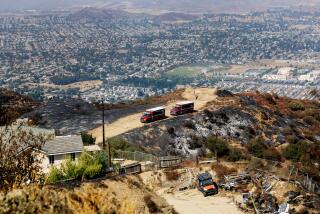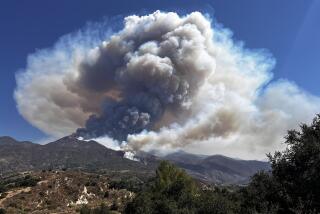‘Rebuild!’ echoes across fire-scarred Santa Rosa, but toxic hazards and red tape could slow efforts
Dee Dee Bridges lost her 3,300-square-foot home in the Fountaingrove neighborhood when fires swept through two weeks ago, and she’s ready to start work on a new home.
“At my age, I am not about waiting,” said Bridges, 70, a retired teacher and former leader of the local League of Women Voters. “We will build it stronger than ever.”
But for Bridges and thousands of others who lost their homes in the wine country firestorms, it remains unclear when they begin rebuilding. Officials are still trying to determine the health hazard in the devastated neighborhoods, and there is some debate about how the government will perform the cleanup needed before new construction can begin.
Questions about how long the cleanup will take has added a note of anxiety to the “#SonomaStrong” and “Rebuild!” monikers that have become ubiquitous as the community tries to turn the page on the tragedy. Santa Rosa alone lost 5% of its housing in California’s most destructive wildfire, and some residents have questioned whether they will be able to afford to stay in a region known for its tight housing market and high prices.
An army of federal crews in white protective suits descended on Sonoma and Napa counties and beyond Thursday seeking to identify and remove the most hazardous waste left behind: propane tanks, oil drums, toxic garage chemicals.
The toxic sweep is the first step of the massive post-fire cleanup — the largest ever undertaken in California — that is expected to take place early next year, state and federal officials said.
U.S. Environmental Protection Agency and state officials will survey all the homes, schools and buildings turned to ash before any debris is removed in Napa and Sonoma counties. Then special teams will move in and remove hazardous waste and test each site for toxic substances.
That cleanup must be completed before residents or the U.S. Army Corps of Engineers may clear what remains on each of the burned-out lots.
It’s a staggering job, with more than 8,000 buildings in wine country destroyed and more than 40 people killed.
“The fires have left an enormous amount of debris on a scale unlike anything we have seen. It has become a monumental task to do,” said Sean Smith, the state’s debris removal coordinator who is overseeing the efforts.
Once the work begins, officials said, about 200 homes will be cleared a day in Sonoma County alone.
Local authorities are asking homeowners to sign a form that requires the property owner to assign to the government any insurance payments for debris removal and give control of that task to the corps. Because of the scale of the destruction, officials believe it would make more sense for one agency to handle debris removal than for homeowners to do it themselves.
Smith said a home insurance policy might provide $10,000 for such a task, but the cost may be far higher and the federal government will cover the extra cost.
“Once the amount is exhausted we don’t want any more money back to the program,” Smith said. “If the insurance is $10,000 and it costs us $40,000, the only obligation the property owner has is $10,000.”

The Federal Emergency Management Agency will fund about 75% of the effort, and the rest will come from the state emergency office.
Smith said work would start near schools, day-care centers and the homes around them first. Eventually, the debris clearance will involve thousands of workers in small teams. Sonoma County officials have already begun collecting authorization at the county health office to clear properties.
A news conference this week by state and federal officials was interrupted by hundreds of homeowners who worried that the corps would remove foundations that could be salvaged, increasing the costs of rebuilding.
“I think some of the foundations could be saved,” said Allen Stephens, a Santa Rosa resident whose son and father-in-law lost their homes in Coffey Park and Marquis Estates.
In an effort to speed up reconstruction, the Santa Rosa City Council and Sonoma County Board of Supervisors approved plans to waive some permit fees, allow administrators to give quick approvals and prioritize approval for destroyed properties.
“What I mainly want to do tonight is to act to assure the community that we are committed to recovery and rebuilding,” Mayor Chris Coursey said during the council meeting.
Already the local hotels are filling up with insurance adjusters and contractors trying to tackle the mammoth task.
Glen Ellen homeowner Elizabeth Takeuchi-Krist said her wood home amid the trees is an ashy shell. Little is left except for her husband’s 360-pound anvil from his time as a blacksmith.
Even many of his heavy metal pieces and her All-Clad pans are melted.
“It is hard to decide where to start,” she said. “Our foundation is pretty small and much of our home is on the hill. So we may have them clear it off.”
Takeuchi-Krist said she hopes they can rebuild even better.
Luckily, she said, luckily the couple’s home insurance package guarantees them funding to rebuild their home at current state codes, including new fire protection requirements.
“We can do more with the home, and we will,” she said.
Twitter: @lacrimes
More to Read
Sign up for Essential California
The most important California stories and recommendations in your inbox every morning.
You may occasionally receive promotional content from the Los Angeles Times.











